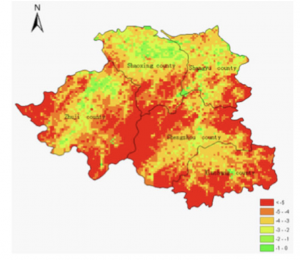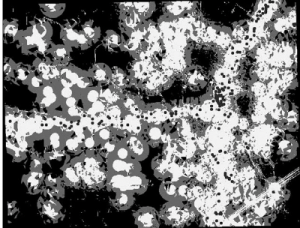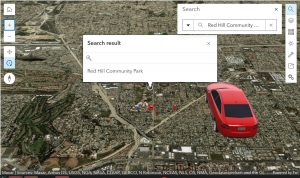Chapter 6 introduced spatiotemporal data, which connects information to both time and location, and showed how it’s used in real life GIS. I found it interesting how real-time data can support emergency response, environmental monitoring, and business operations. The chapter explained different types of spatiotemporal data, the role of IoT devices, and tools like ArcGIS Dashboards and time-enabled layers. It was really helpful to see how live data can be visualized and animated to track changes over time.
Grogan – Week 3
In Chapter 3, I learned about the ArcGIS Experience Builder, which lets you create custom web experiences with flexible layouts and interactive widgets. It’s really useful when a standard web app doesn’t meet your needs. The tutorials were helpful, but it took some time to get used to working in a web-based environment after using local software all semester. I liked how the Experience Builder can make GIS more accessible even for people with little experience.
Chapter 4 focuses on how mobile devices are becoming the main platform for Web GIS. I thought it was really interesting that GIS can even work on wearable devices like Apple Watches. I also liked how the chapter introduced different Esri mobile apps and explained them clearly. The idea of rapid data collection and the shift toward mobile GIS made me realize how important it is to access data quickly and easily, especially in the field.
One application would be a wildlife tracking app where users can log wildlife sightings (species, location, time, photo) directly from their mobile devices. Using Web GIS, the data could be mapped in real-time to help conservationists monitor animal populations, migration patterns, or even invasive species. The Experience Builder could make it easy for users to view maps, contribute data without needing coding experience, and even get alerts if they are near sensitive habitats. This would help connect everyday people to environmental research while building a large, useful dataset for scientists.
Powell Week 4
Chapter 6
This chapter focused on explaining how to create a dashboard web app and looked at spatiotemporal data and real-time GIS. I vaguely knew of what these terms mean but I still always think it is so crazy how easy it is now to get real-time data. I always find it interesting to see how GIS can be found in real life settings and events. In the first half of this chapter it goes over how to create a dashboard that shows 911 calls along with incident reports. I found the way this information was laid about to be very engaging but I did find it a little overwhelming as I was having issues with sizing the map. The rest of this chapter was easy to follow and showed how to create a time-enabled feature layer along with how to animate time-series data.
For this chapter I think for this I would want to make an application that involves creating a dashboard to look at specific crime incidents in Delaware.
Powell Week 3
Chapter 3
This chapter looked into ArcGIS Experience Builder and how it is a highly configurable app. The first section of this tutorial (3.1) took a look at how to use Experience Builder to create a web app that can display historical earthquakes and hurricanes in 2D and 3D maps. I found these instructions to be vey straightforward and it was interesting to see the comparison. I really liked how specific each function was and found this to be a useful tool and my only main issue was with finding where specific things that the instructions were leading you to as I think the layout of the overall app has changed and I think some of the stuff required you to select something for it to show up. It wasn’t hard to figure it out it was just annoying that these instructions weren’t as straightforward considering that everything else has been easy to follow.
Chapter 4
This chapter looked into Mobile GIS and I found it interesting how it was saying that the Survey123 can be used to recognize specific things such as leaves or street signs. The first part of this chapter focused on explaining how to create a survey which was super easy to follow and reminded me a lot of Google Forms. The app was a little bit unnecessary to download as you could just get the link from the QR code provided to test the survey. Survey123 seemed like a good way to collect to data and I liked the way the data was laid out. I had some issues with the app as it kept crashing but that might just be my phone. I thought it was interesting overall to see just how much we are moving towards data collection on smart devices rather then the traditional data collection through computers which is interesting because it just means that collecting data is going to become more accessible and easier to do and maybe possibly even more accurate.
Based on these ideas I think this could be used in Delaware to report specific incidents by using Survey123 which could be linked to a map so that people are aware of where incidents occur.
Powell Week 2
Chapter 1
The first chapter went over the basic concepts of Web GIS and looks at some of the tools available. I found these instructions to be very clear and found that it showed a good idea of the basics of what Web GIS has to offer. The pictures shown in these tutorials were very easy to follow and were super helpful by being a guide to make sure that I am in the correct place for the steps.
Chapter 2
This chapter looked more into different types of layers along with the concept of story telling in Web GIS. This chapter was easy to follow as a lot of it were things I had previously seen throughout the first half of this class (GEOG 291). I felt as though creating the layers was very similar on Web GIS as it was on the Desktop version (ARCGIS) which was nice as I was familiar with the content. When it came to tutorial 2-3 I was having some issues with getting it to work as but overall everything else was pretty easy to follow.
An application based on ideas from Chapters 1 & 2 could be looking at the use of mapping to see the specific attributes of the population that is impacted by Delaware being a food desert.
Heumasse Week 5
Chapter 7 Notes and Reflection
Focuses on 3D web scenes and how they allow spatial data to be displayed in more immersive and interactive ways. The chapter explains the difference between photorealistic scenes, which use real textures and imagery to mimic the physical world, and cartographic scenes, which represent data using more traditional symbols and styling in a 3D format. The chapter also introduced key scene elements, including surfaces, features, textures, and atmospheric effects. These elements work together to give users a better sense of space, scale, and elevation. I also learned about Lidar, which uses laser-based sensors to collect high-resolution spatial data, shown as point clouds that can represent features like building outlines or terrain elevations. Other technologies introduced included virtual reality (VR), augmented reality (AR), and extended reality (XR), which are part of the growing shift toward immersive digital environments. The tutorials explained how to build 3D scenes, manage layers, and apply visual settings like lighting and time-of-day to enhance the scene’s appearance.
Application Ideas
Based on the concepts from this chapter, one possible use of 3D web scenes could be a zoning and land use map of Delaware County. Parcel data from the Delaware Data Inventory could be used to extrude buildings or land areas by zoning type. With 3D symbols and color-coding, users could quickly understand how land is being used and how it varies across the county. Another possible application would be to use building outlines and elevation data to explore how urban development in the area has changed over time. Combined with time-enabled layers, this could support planning or sustainability efforts by visualizing building growth and land use change in a clear, spatial format.
Heumasse Week 4
Chapter 6 Notes and Reflection
Introduced the concept of spatiotemporal data, which refers to data connected to both time and location. I learned that this kind of data is essential for tracking patterns that change over time, such as weather events, traffic, or environmental conditions. The chapter also explained how spatiotemporal data fits into real-time GIS, where live updates from sensors and devices can be used to inform decisions. One term that stood out was the Internet of Things (IoT). It refers to physical objects, like traffic cameras or air quality monitors, that are connected to networks and constantly sending out data. I hadn’t really considered how often we interact with systems like this in daily life. The chapter also introduced ArcGIS Dashboards and time-enabled layers. Dashboards display real-time data in charts, lists, and maps, making it easy to monitor change or activity in one place. I thought it was helpful to learn how different types of spatiotemporal data, like discrete incidents or moving objects, can be visualized in different formats depending on the purpose. Another useful part of the chapter was the breakdown of how to animate time series data. This involves publishing a time-enabled web layer and creating a time slider on a map to show how something changes across specific intervals. I could see how this would be valuable in many fields, especially for things like public health, climate monitoring, or urban growth.
Application Ideas
Chapter 6 introduced how time-enabled data can be used to track changes and events across both space and time. Building on this, an application that fits well with these tools would involve creating a time-enabled web map of reported traffic incidents or emergency calls in Delaware County using layers from the Delaware Data Inventory. The goal of this application would be to visualize when and where incidents are happening most often. By enabling a time slider, the map could show how incident patterns shift by time of day, week, or season. A simple dashboard could include real-time charts and filters for types of incidents or location categories, helping users explore patterns quickly. This kind of project would be helpful for identifying areas with high activity and could support local planning or public safety awareness.
Jolliff Week 2
Chapter 1&2
Chapter 1 was really kind of an introduction into ArcGIS. Some basic history, what it is used for, and how we can apply it. This is mostly a recap of things I learned in GEOG 291. However, this is help to re-visit. the frame work to Web GIS apps was interesting to read about. I found it interesting about the different way you can set up an app. Chapter two about smart mapping and storytelling was interesting. Introducing map layers was good so that you can see what the building block of web apps are.
An app idea that think would be interesting to explore would be an app that shows interactive maps that show photos of specific places. In particular I think a map that shows images of the different parks around where I live would be interesting. Seeing as there is not a whole lot of advertising for the parks around where i live this would be a way people could look at the parks and see if it was something they would be interested.
Jolliff Week 1
My name is Hazel Jolliff I am a Junior and I took GEOG 291 before spring break so I have a bit of an idea of how ArcGIS works. I found it interesting to go through the online course and see how ArcGIS online works. I thought it was cool that you can make groups and organizations. I think that it is helpful to be able to share things . it was a good refresher about base maps and operational layers, I had almost forgotten about those.
My Searches:
#1. My search was “ GIS” and “Crop Damage”

Reference: Lou, W., Ji, Z., Sun, K., & Zhou, J. (2013). Application of remote sensing and GIS for assessing economic loss caused by frost damage to tea plantations. Precision Agriculture, 14(6), 606–620. https://doi-org.owu.idm.oclc.org/10.1007/s11119-013-9318-5
The article titled “Application of remote sensing and GIS for assessing economic loss caused by frost damage to tea plantations” focused on developing a way to determine economic loss due to spring frost in tea plantations. The map used remote sensing and GIS to form a spatial distribution of temperatures in the given production area.

#2. My search was “ GIS Application” and “Archaeology”
Reference: Ebert, D. (2004). Applications of Archaeological GIS. Canadian Journal of Archaeology, 28(2), 319–341.
The journal was titled “ Applications of Archaeological GIS”. This is an example of a predictive model, the dark circles represent existing sites that were used to base
Fondran Week 5
Chapter 7:
This chapter focused on 3D web scenes and what I found interesting was the metaverse. Specifically, the book mentioned Fortnite, a game I love to play as an application of the aspects of the metaverse. As I created the first map scene it started to become illegible even though I was following the steps from the book. Since it was not looking correct I changed a few things around; For tutorial 7.2, I changed km to inches for Pop. Per sq. Mi. to visualize the population data. This may be because the data set referenced in the book may not have been the same as mine or it has been updated since the book’s publication. Tutorial 7.3 posed a bit of a challenge since I was not in the right “‘Red Hills Community Park” luckily I was able to find it once i started to realize! I ran into another problem after finding the park…For some reason the car attribute must be attached to the wrong data or I missed a sizing step when symbolizing. Even though I ran into this problem, this chapter was really fun and I enjoyed making a fun park. 

Application:
Ohio Wesleyan could gather data of everything on campus to make a public web scene for anyone to access. This could be used by students to find certain buildings or amenities on campus. New students and visitors could use this as an easier way to orient themselves when trying to tour the campus; allowing for a better transition and positive tour experience. Our campus is pretty small but buildings like Sanborn or the soccer field are not directly on campus and with a web scene you can discover all the extra spaces on campus you might not know are there.